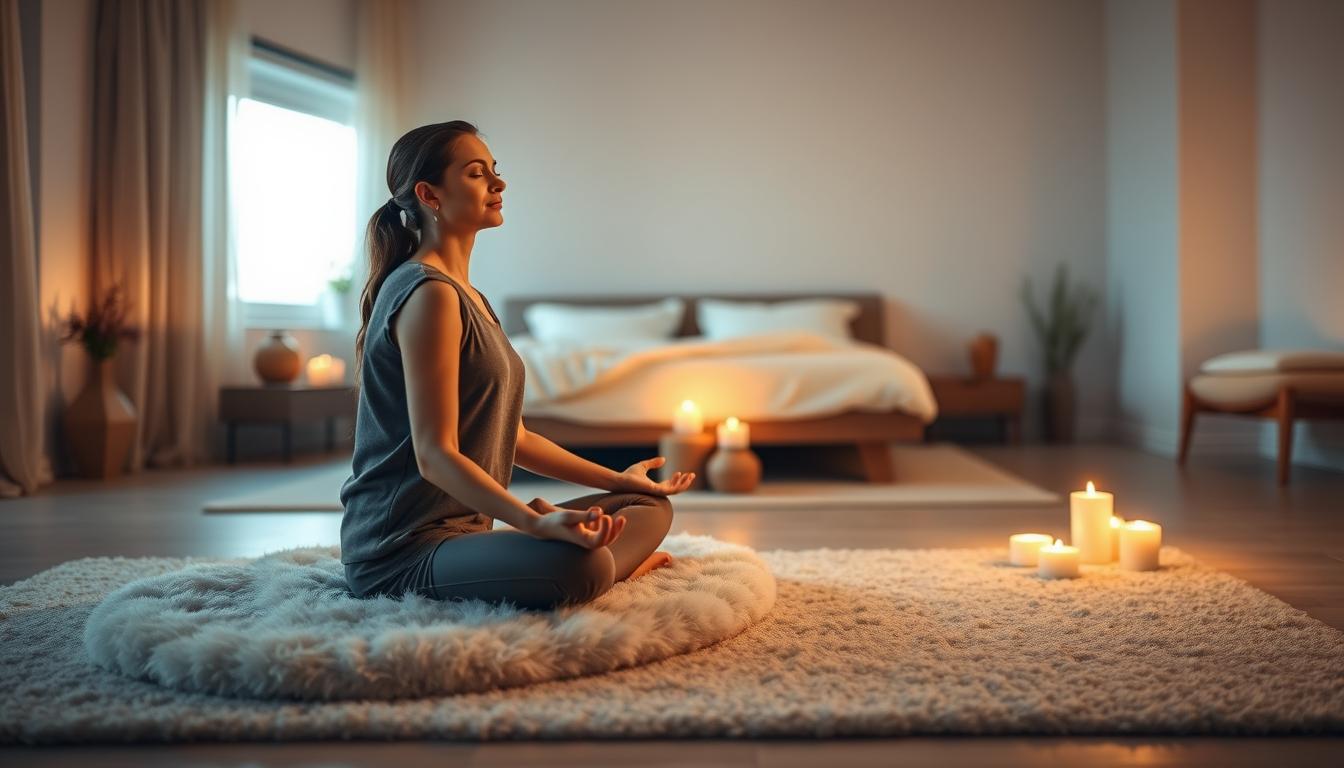Your Guide to 10 Mindfulness Tips for Stress Relief and Sleep


Do you find yourself lying awake at night, your mind filled with stress and anxiety? You’re not alone. Millions of people face stress and sleep issues. But, there’s a powerful tool that can help: mindfulness practices.
Table of Contents
ToggleBy adding simple stress relief techniques to your daily life, you can calm your mind and body. This can also improve your sleep quality. Our guide offers sleep improvement tips through mindfulness. You’ll get practical advice to change your sleep and overall well-being.
Find out how mindfulness can be your ally for a good night’s sleep and a stress-free life. Let’s explore the world of mindfulness together.
It’s important to know how mindfulness works to understand its benefits. It helps manage stress and improve sleep quality.
Mindfulness changes your brain and body in good ways. It helps with stress and emotional control. This leads to lower stress hormones, making you calmer and better rested.

Stress, mindfulness, and sleep are linked in a complex way. Stress can hurt your sleep, but mindfulness can reduce stress. This improves your sleep.
| Benefits | Mindfulness Practice | Impact on Stress and Sleep |
|---|---|---|
| Reduces stress hormones | Regular mindfulness meditation | Decreases cortisol levels, improving sleep quality |
| Enhances emotional regulation | Mindful breathing exercises | Reduces stress, promoting relaxation before sleep |
| Improves sleep quality | Body scan meditation before bed | Increases deep sleep duration, reducing sleep disorders |
Knowing how mindfulness affects stress and sleep is key. It shows why adding mindfulness to your day is good for your well-being.
Discover the top 10 mindfulness techniques to ease stress and better sleep. Mindfulness practices are known to help relax and lower anxiety.
The power of these mindfulness meditation exercises comes from calming the mind and relaxing the body. They help you stay in the present, reducing worries about the past or future. This leads to a more peaceful state.
To make mindfulness a part of your life, start with small steps. Add relaxation methods to your daily routine, even for just a few minutes. Being consistent is key to seeing mindfulness benefits. Try different techniques to find what suits you best.

By sticking to a mindfulness routine, you can boost your well-being. You’ll learn healthier ways to handle stress.
Mindful breathing exercises can greatly reduce stress and improve sleep. They are a key part of mindfulness, helping to calm your mind and body. By focusing on your breath, you stay present, letting go of past and future worries.
The 4-7-8 method, or “Relaxation Breath,” is simple. Breathe in through your nose for 4 counts, hold for 7, and exhale through your mouth for 8. It slows your heart rate and promotes relaxation.
Box breathing is another great technique. Breathe in for 4 counts, hold for 4, exhale for 4, and hold again for 4. This creates a “box” shape with your breath, bringing balance and calmness.
Diaphragmatic breathing, or belly breathing, uses your diaphragm instead of shallow chest breathing. Place one hand on your belly and the other on your chest. Your belly should rise as you inhale. This type of breathing calms your nervous system before bed.
Some key benefits of mindful breathing exercises include:
By adding these techniques to your daily routine, you can feel calm right away. You’ll also see long-term benefits for your well-being.
Body scan meditation is a key mindfulness technique for managing physical tension. It involves focusing on different body parts to release tension.
To start, find a comfy position, like lying down or sitting. Close your eyes and breathe deeply. Begin with your toes, noticing any feelings or tension.
Slowly move up your body, checking each area. This includes your feet, ankles, and all the way to your head. If you find tension, breathe into it and imagine it leaving with your breath.
For better sleep, do body scan in bed. Lie down and focus on relaxing each part of your body. Let go of tension with each breath.
If your mind strays, bring it back to the current body part. This helps you relax and sleep better.
Body scan meditation is great for those with chronic stress and sleep issues. It helps release tension and improves sleep quality. Regular practice can also lower stress levels, making it easier to sleep.
Mindful movement and gentle yoga are great for managing stress and getting ready for sleep. They mix physical activity with mindfulness, making a complete approach to health.
Doing gentle yoga at night tells your body it’s time to sleep. Poses like Child’s Pose, Legs-Up-the-Wall Pose, and Reclined Spinal Twist calm your nervous system and relax your body. “Yoga is the journey of the self, through the self, to the self,” says The Bhagavad Gita. It boosts flexibility and helps you relax before bed.
Mindful walking is a great way to reduce stress. It focuses on your walking, feeling your feet on the ground, and your breath. It’s perfect for work breaks or before bed. Jon Kabat-Zinn says, “The best way to take care of the future is to take care of the present moment.”
Tai Chi and Qigong are ancient Chinese practices. They mix slow movements, deep breathing, and meditation. They lower stress, improve balance, and boost well-being. Adding them to your daily routine can help manage stress and sleep better. Regular practice can greatly reduce stress and improve health.
Adding these mindful movement practices to your routine can improve stress management and sleep. Be patient and let your practice grow over time.
Guided visualization and progressive relaxation are great for reducing stress and improving sleep. They help you create a peaceful space in your mind and release physical tension. This prepares your body for a good night’s sleep.
Guided visualization lets you imagine a calm, relaxing place. To make your own relaxation sanctuary:
This method takes your mind off stressful thoughts and calms your nerves.
Nature scenes can help you sleep better. Imagine:
These pictures can make you think of nature as a place for rest and sleep.
Progressive muscle relaxation is about tensing and relaxing muscles. To do it:
This method helps release tension and leads to deep relaxation.
Using guided visualization and progressive muscle relaxation can improve your sleep and reduce stress. Regular practice can make you feel better and more resilient to daily problems.
Mindfulness is more than just meditation. It also includes mindful eating and digital detox. These practices can greatly improve your well-being.
Mindful eating means focusing on every bite. It’s about enjoying your food and listening to your body’s hunger signals. This can lead to a healthier relationship with food and better digestion.
Eating right is key, but when you eat matters too. Try to avoid big meals before bed. If you’re hungry, a light snack is better.
Your evening meal should have carbs, proteins, and fats. Here are some good options:
| Food Type | Examples | Benefits |
|---|---|---|
| Complex Carbohydrates | Oatmeal, whole grain bread | Promotes serotonin production |
| Lean Proteins | Chicken, fish | Supports muscle repair |
| Healthy Fats | Nuts, avocados | Enhances satisfaction and nutrient absorption |
In our digital world, it’s important to disconnect before bed. Screens can mess with your sleep hormone, melatonin.
Set a “no screen” time before bed, like an hour or two. Use this time for relaxing activities, like reading or listening to music.
Switching to mindful activities can help you relax and get ready for sleep. Try these:
By adding mindful eating and digital detox to your routine, you can improve your sleep and reduce stress. These mindfulness practices are key to a better life.
Gratitude practices and bedtime meditation can greatly improve your sleep and well-being. Adding these mindfulness meditation exercises to your evening routine can lead to deep relaxation and better sleep.
Starting a nightly gratitude ritual is a simple yet effective sleep improvement tip. Spend a few minutes each night thinking about what you’re thankful for. You can write in a gratitude journal or share three things you’re thankful for with someone.
Thinking about the good things in your day can help you relax. It makes it easier to fall asleep by reducing stress and anxiety.
A five-minute bedtime meditation practice is great for unwinding. Find a quiet, comfy spot to sit or lie down. Focus on your breath, or use a guided meditation app.
This relaxation method calms your mind and gets your body ready for sleep.
Journaling is a great way to clear your mind before bed. Writing down your thoughts and feelings helps you process your emotions. It releases tension and stress.
If you often wake up with racing thoughts, journaling can help. Make it a regular part of your bedtime routine. You’ll find it easier to fall asleep and stay asleep.
Now that you’ve learned about 10 mindfulness techniques, it’s time to make a routine that fits your life. Mindfulness is most helpful when you do it regularly. So, pick the techniques that feel right to you.
Start by adding one or two techniques to your daily life. Try mindful breathing or body scan meditation before bed. As you get more comfortable, you can add more techniques to help you sleep better.
Think about what you like and when you have time for mindfulness. If mornings aren’t your thing, try evening yoga or a bedtime meditation. The important thing is to stick with it and make mindfulness a regular part of your life.
Creating a mindfulness routine that meets your needs can help you manage stress and sleep better. Try out different techniques and mix them up to find what works best for you.